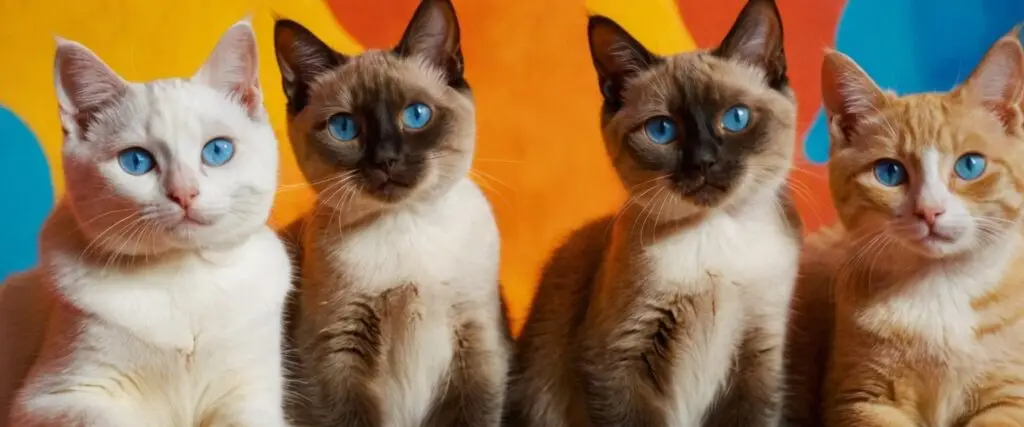In this article, we will share what we know about blue eyes cats. We will explain why they have blue eyes. We will also discuss which breeds have this rare trait. Additionally, we will cover possible health issues and how to care for them. Finally, we will look at some myths about blue-eyed cats. If you are adopting or are simply curious about feline genes, this article is your one stop solution.
Why Blue Eyed Cats Are So Special?
Something impossibly captivating about a blue-eyed cat. Maybe it’s how they fix their cold stare on the light. Or maybe it’s just that this trait is rare in adult cats. Blue-eyed cats are one of the world’s most prized pets. Those sparkling peepers aren’t just beautiful — they’re also a genetic anomaly. Every newborn kitten possesses blue eyes, but only a handful hold onto it into adulthood.
Blue eyes in cats usually come from genetic factors. These can include coat color, breed, or pigmentation patterns. They may have them due to albinism or the dominant white gene. They may also have them, like the Siamese, because of temperature-sensitive pigmentation.
What Causes Blue Eyes in Cats?

Genetics and Melanin
Melanin — the color pigment found in eyes, skin, and fur — is to blame. In blue-eyed cats, there is very little or no melanin present in their iris. This causes the light to scatter in a different way throughout the eye, producing the blue effect. It is the same effect that gives the sky its blue color — it’s a matter of light scattering.
Light Reflection and Iris Structure
A cat’s eye itself has no blue pigment. Blue manifests as an effect of the scattering of the light against the layers of the iris. The less there are pigments, the more there is scattering and thus, a blue color. Hence, even multi-colored cats may have the same light blue eyes — it is not fur, it is eye anatomy.
Pointed Genes vs Dominant White Gene
There are two main genetic reasons a cat could potentially have blue eyes:
The Pointed Gene (cs gene) is found in breeds like Siamese. This gene affects the coat color and eye color, especially on the lower parts of the body. The Dominant White Gene (W gene) suppresses all pigmentation. It can create cats with white coats and blue eyes.
It is also linked, however, to an increased rate of congenital deafness. These genes will work together to create the same eye colors. However, they do this in different ways, which can affect health in various ways.
Do All Kittens Have Blue Eyes?

Why Kittens Start With Blue Eyes
Yes, blue eyes are present in all new kittens. This is because their irises lack melanin for the first few weeks of life. They were born with their eyes closed, and if they do open up (at 7–10 days), they are blue.
When and How Eye Color Changes
As they mature, their eyes start producing melanin. At the age of 6 to 8 weeks, their permanent eye color is set in — typically green, amber, or gold. Blue appears only in certain genetic conditions.
Breeds Where Blue Remains Permanent
Breeds such as Siamese, Himalayans, and Ragdolls keep their blue eyes into adulthood because they carry the pointed gene. Other breeds such as Khao Manee or Ojos Azules naturally occur with blue eyes as well.
Top 10 Blue Eyes Cats Breeds
Blue eyes in cats are extremely rare and, in most cases, with certain breeds and genes. These are the top 10 blue eyes cats breeds, including personality types and color varieties.
1. Siamese
Hands down the most sought-after blue-eyed cat, the Siamese is refined, expressive, and highly intelligent. Siamese has almond-shaped blue eyes that are dramatic when contrasted with their pointed fur. Siamese cats are affectionate, human-centered, and adore being around people. Their eye color remains bright life-long because of the albinism temperature-sensitive gene.
2. Ragdoll
Ragdolls are soft and quiet cats. They are like snuggle monsters. When you pick them up, they go limp. Their name fits them well. They have a soft, semi-long coat and melodramatic blue eyes ranging from pale sky-blue to sapphire. They are extremely adaptable to domestic life and are happy to stay indoors.
3. Balinese
One of the longest-haired Siamese, Balinese cats also possess pointed coat and blue eyes. They are beautiful, playful, and very loyal. They possess silky, fine coats, and one of their best traits is bright blue eyes.
4. Birman
Birman cats are highly affectionate and gentle, usually strongly bonded with people. They possess medium to long-length coats, white mitt-like paws, and gorgeous round blue-colored eyes. Birmans are friendly but playful ones, and they’re the family favorite.
5. Snowshoe
Not very recently bred hybrid, Snowshoes are a Siamese-American Shorthair cross. They continue the blue eye color of the Siamese parentage with white markings on face and paws. Chatty, friendly and used to following people around.
6. Himalayan
A hybrid of a Persian and a Siamese, the Himalayan is a flat-faced high-bred cat with blue eyes and a long coat. Their blue eyes are stunningly complemented by their soft coats. They are friendly, affectionate, and need to be groomed once a day.
7. Khao Manee
A very old and reserved Thai breed, the Khao Manee (“white gem”) tends to have lovely blue eyes or foreign-colored eyes. Its short, white fur and diamond eyes give it an ethereal quality. They are intelligent, curious, and extremely energetic.
8. Tonkinese
Tonkinese cats have a combination of Burmese and Siamese characteristics. They often have beautiful aqua or teal eyes, which are a mix of green and blue. They are known to be calm and sweet-natured. They are intelligent and enjoy having games or puzzle toys.
9. Turkish Angora
Beautiful and delicate, the Turkish Angora is a refined and silken-coated cat. Although they may have all manner of eye color, some are born with beautiful, odd, or blue eyes. Turkish Angoras are playful, high-energy, and would rather attach themselves to one person in a household.
10. Ojos Azules
The most unusual of all is the Ojos Azules. This name means “Blue Eyes” in Spanish. It is a blue-eyed cat breed. It has a unique pattern and does not need the pointed gene or a white coat. Blue eyes, black, tortie, or tabby coats can occur in this breed anomaly that’s standing alone with blue eyes. Their gene pool is limited, so they are rather difficult to find.
Is It Rare for a Cat to Have Blue Eyes?
Yes — in cats, real blue eyes are not typical. Other than certain breeds or genetic disease, most cats become yellow, green, or amber-coloured when they mature. Less than 5% of non-pedigreed housecats keep blue eyes throughout their lifetime.
It is also worth noting that blue eye and gold/green eye odd-eyed cats and blue-eyed cats are distinct from one another. Odd eyes are more common in white-coated cats. This happens because melanin is only partially expressed in one eye.
Are Blue-Eyed Cats Usually Deaf?
This is a science-backed common myth. While deafness in all blue-eyed cats is not necessarily true, deafness is more commonly found in cats who are:
- White-coated
- Carriers of the dominant white (W) gene
- Bilaterally two blue eyes (risk for deafness is higher than in unilateral cats)
It’s because the same gene that inhibits pigment formation in eyes and fur is disrupting the developing inner ear. Blue eyes caused by the pointed gene, such as those seen in Siamese or Ragdolls, have nothing to do with hearing problems.
Do Blue-Eyed Cats Have Vision Issues?
Not usually. Blue-eyed cats are usually seen as regular cats. Some Siamese cats, however, do have strabismus, where their eyes cross. It appears strange, yet it doesn’t usually affect vision.
Albino cats (which also have very pale blue eyes) are light-sensitive and may squint or avoid lighted spaces. Blue-eyed cats are generally not blind compared to other cats.
What Does It Mean if My Cat Has Blue Eyes?
It usually means your cat has certain genes. These can come from a specific breed, like Siamese or Ragdoll, or from dominant white or spotting genes. Although no evidence of pedigree, blue eyes can mean something in terms of your cat’s background.
Blue-eyed cats are strange or unusual-looking by cultural standards. They are sometimes thought to be guards or even good luck charms.
Are Blue Eyes Linked to Health Problems in Cats?
Blue eyes themselves are not unwell. They are occasionally part of a condition when they appear with other characteristics:
- Deafness (blue eyes and white cat)
- Cataracts or glaucoma (not blue eye color, age-related)
- Eye infection or cloudy cornea
Always monitor for cloudiness, discharge, or any other behavior that would suggest loss of vision in your cat’s eyes.
Do Deaf Cats Meow?
Yes, and sometimes louder than hearing cats. Since they are unable to hear themselves, deaf cats will at times create substitute or louder sounds. They can live happy lives — they just “speak” in body language and vibration.
- Tips to care for a deaf cat:
- Use visual cues or light cues
- Keep them indoors for protection
Provide them with additional mental stimulation
What Is the Price of a Blue Eyes Cat?
Prices vary widely depending on breed and lineage. Here’s a rough idea:
| Breed | Price Range (INR) |
|---|---|
| Siamese | ₹50,000 – ₹1,00,000 |
| Ragdoll | ₹66,000 – ₹2,00,000 |
| Balinese | ₹58,000 – ₹1,25,000 |
| Birman | ₹83,000 – ₹1,65,000 |
| Khao Manee | ₹1,65,000 – ₹9,15,000 |
| Ojos Azules | Rare – rarely available in India |
| Himalayan | ₹41,000 – ₹1,25,000 |
Adoption is a great option, too. Many rescues have blue-eyed cats in need of homes. Check local shelters or breed-specific rescues.
How to Care for a Blue-Eyed Cat
Blue-eyed cats do not need special care. However, if they are delicate breeds like Himalayans, consider these tips:
- Eye care: Gently wiping with a washcloth and mucus
- Vision safety: Indoor living or covered resting spots
- Coat care: Daily brushing for long-haired varieties
- Stimulation: Playtime and a climbing area preclude dullness
How to Fix Cloudy Eyes in Cats
Cloudiness can be due to:
- Cataracts
- Glaucoma
- Corneal ulcers
- Infections
If your cat is developing blue eyes, take him to a vet right away. Damage can be avoided from ever occurring if found early enough. Never try home treatment before consulting an expert.
At what Age Do Cats Get Blue Eyes?
All blue eyes in kittens are congenital. Changing eye color for life is at 6 to 12 weeks of age. If it does not change by 12 weeks, your cat most likely has a genetic trait that retains blue eyes for life.
Are all blue-eyed Eyes Cats Siamese?
No. Blue-eyed Siamese are probably the most well-known blue-eyed breed, but not the only ones. Ragdolls, Birmans, Snowshoes, Himalayans, Khao Manee, and a few more have blue eyes naturally.
What Do You Call a Black Cat with Blue Eyes?
This unusual cross is likely an Ojos Azules. This cat breed has a genetic mutation for a dark coat and bright blue eyes. They’re extremely rare and not typically outside of specialty breeders.
Are Blue-Eyed Cats Color Blind?
No, and cats are a little color blind, too. Cats perceive colors primarily as blue and green and are red blind. Blue eyes do not affect their color vision whatsoever — it’s simply a frequent feline fluke.
Blue Eyes Cats FAQs
1. Can any cat have blue eyes?
No, by nature — only blue-eyed cats with unique genetics retain blue eyes after kittenhood.
2. Are blue-eyed cats rare?
Yes, especially in non-pedigreed adults.
3. Do white cats always have blue eyes?
No, though the dominant white gene is said to result in blue or odd eyes.
4. Are blue-eyed cats deaf?
No. Blue eyes have more to do with eye color and less to do with white coats.
5. Is blue eye color a cause of blindness?
No. Blue eyes are not a cause of blindness, but do check for cloudiness or discharge.
6. What breed of cat is best described as having blue eyes?
Siamese and Ragdolls are renowned for bright, deep blue eyes.
7. How do I check if my cat’s blue eyes are permanent?
Wait 12 weeks – if they haven’t changed, they probably will stay blue.
8. Will blue-eyed mixed-breed cats be so?
Yes, if they have the right genotype.
9. What are cloudy blue eyes?
Maybe cataracts, infection, or trauma get a vet.
10. Can normally blue-eyed deaf cats survive?
Yes- they soon learn to adapt with other senses.
Blue-eyed cats are not just cute faces — they’re nature’s perfect work of art genetically. Having a blue-eyed cat as a pet is a wonderful experience. You might love their beautiful looks. You may also be curious about their eyes.
If you’d like to adopt, simply look around your local rescues and breed-specific rescues. Blue-eyed beauties are waiting for their forever homes — and perhaps you can be the individual waiting just for them.
Ready to bring a blue-eyed cat home?
Start with this guide on finding the perfect cat for your lifestyle. Give a forever home to an amazing creature with eyes as blue as the sky.
Author – Navdeep Kr., a passionate dog lover and proud pet parent who has completely changed my life. Over the years, I’ve learned so much about the ups and downs of caring for dogs — from their first bath to their silliest grooming moments.
I’m not a professional groomer, just a pet parent who believes every dog deserves love, patience, and proper care. Through my blogs, I share my real-life experiences, what’s worked for me, and even the little mistakes that helped me learn along the way.
When I’m not writing or working, you’ll probably find me exploring pet-friendly cafés, playing fetch at the park, or simply cuddling with my furry buddy after a long day. My goal is simple — to help other dog parents feel more confident and connected with their pets every single day.

